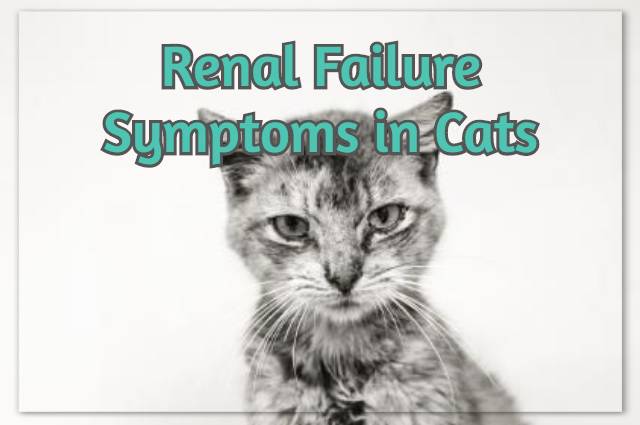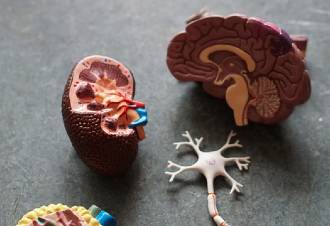
Our cat has a number of different illnesses, one of which is the early stages of Renal failure. She is 15 years old, so it is to be expected, unfortunately. She still acts like a kitten occasionally, but her illnesses do take their toll sometimes. Renal failure symptoms in cats can mean them drinking more often and, therefore, weeing more often, plus other issues.
I hope today that I can share with you the Renal failure symptoms in cats and also some technicalities of the disease. Of course, it goes without saying that if you notice anything unusual, you need to consult a vet in the first instance.
==============================================================
Kidney failure in cats is almost 7 times more common than in dogs
=============================================================
A cat’s urinary system contains 4 sections: the kidneys, ureter, urinary bladder and the urethra. It is influenced by hormonal regulation and this, in turn, regulates sodium and blood pressure in the system. Blood pressure is increased by the amount of sodium your feline friend has digested, and the amount of sodium will determine the levels of water retention in the body.

Sodium reabsorption in the kidney is handled by a hormone called Aldosterone. If this increases, the reabsorption of water into the organ will also increase, especially if the antidiuretic hormone ADH also increases as this prevents diluted urine from being produced.
Impaired kidneys mean that the patient retains more fluid than is necessary for their body. Too much fluid can result in oedema of the limbs or fluid accumulation in body cavities and tissues – sometimes called “third spacing”.

Renal injury can be broken down into three parts:
- Prerenal (occurs before filtration) – conditions such as dehydration, shock, or low blood volume (poor renal blood flow)
- Renal – conditions of Acute Renal Failure (ARF) or Chronic Renal Failure (CRF):
-
- ARF symptoms – enlarged kidneys, oliguria or anuria, and fast decline in kidney function. ARF can be caused by toxins, heatstroke, diabetes mellitus (DM) and other metabolic diseases.
-
- CRF symptoms – elderly, dehydrated cats. Often they show a history of weight loss, excessive thirst and urination. Patients with CRF produce large amounts of urine. They have smaller kidneys compared to cats with ARF. CRF can be due to kidney infection or chronic poisoning of the organ. Nephritis can also cause CRF – a degenerative condition of the nephrons. Nephrons are the filtration units of a kidney. As the nephrons are gradually destroyed, the health of the cat gets worse.
- Postrenal – lower urinary tract perforation or obstruction. Kidney stones may show in an obstructed ureter.

Renal failure may also be due to:
- Pyelonephritis – a bacterial or yeast infection in the kidney
- Polycystic renal disease – an inherited congenital condition where the renal pelvis is distended with urine. With time, the tissue becomes fibrotic.
Patients with renal injury should eat low protein diets as this reduces the effort asked of the kidneys.
Anaemia may also be seen as the kidneys produce the hormone Erythropoietin.
Stages of Renal Failure

At The Clinic
Cats have to be monitored fully, and fluid therapy checked for urine output. Any fluid losses from vomiting or diarrhoea should also be calculated by veterinary staff. Staff are typically advised to place an indwelling urinary catheter to aid in accurate monitoring of your cat.
Minimum production should be 1-2 mL of urine per pound per hour. Below this level, additional therapy will be considered.
You may be advised that diuretics or medications are required to dilate the renal arteries, which in turn promote blood flow to the kidneys.
Mental State of Mind
A cat with renal failure should also be assessed for their mental state of mind as multiple organ dysfunctions could take place quickly if the kidneys deteriorate further. The cat should also be checked for uremic ulcers (oral ulceration caused by a high level of urea in the bloodstream). Many mouth rinses will be scheduled.
Veterinary staff should weigh patients every 12 hours. In severe cases, every 2-4 hours. Bodyweight assessment and fluid balance intervals may need to be increased as well.
Outcome
It is only natural that the kidneys start “misbehaving” as the cat grows into old age. However, renal failure can occur at any age due to poisons such as toxic plants or antifreeze ingestion as well as other causes.
Like humans, early detection will improve their survival and quality of life. We were advised to place two or three bowls of water, rather than just one, around different parts of the house so our cat would feel more comfortable drinking more often and lessen the risk of her running out of water. We also bought a high-quality cat litter which absorbs more urine, and we clean it out more often.
Then there are numerous veterinary-grade foods available. Cats with this disease need low protein nutrients and all the major players in this field (Royal Canin, Hills etc) all produce a “renal” food of some kind – biscuits, mousse, wet food etc.
Renal Failure Symptoms in Cats – A Quick Guide
Does your cat have renal failure? What symptoms did you notice initially? Do you know what stage they are at? Please comment below and share with your friends and family.






Hi Susie,
Thank you for this very informative article.
I always knew that cats were more prone to kidney failure because their urine is extremely concentrated.
However, I didn’t know that it could be related to sodium intake and hormone levels.
Very interesting.
This post is a little piece of prevention, so I appreciate all of your effort in putting it together.
Keep up the good work! The animals thank you!
Michael
Hi,
Renal failure seems to be very common. I had a cat once, his name was Bagheera, he was a gorgeous black cat with yellow eyes. He got kidney failure and I took him to the vet, but we could not save him. He passed away, and it broke my heart. I had had him since he was a baby, I rescued him when he was only 3 days old and bottlefed him.
I heard that it is also advised to often give your cats wet foods to prevent any renal failures, so that’s what I do as well. Thanks for sharing the foods we can give them, I will take a look at that. Royal Canin and Hills are very good brands.Are there any other brands you recommend?
I just happen to share your cats renal failure health problem, and my 7 year old Rottweiler just passed away in February with Cancer.
Have you ever wondered why our pets are so unhealthy now, I think it is whatever they are putting in their food.
What do you think about this,
Jeff
Hi Michael. Thank you for your comment. Cats are full of mystery! It´s so difficult to know everything unless, of course, you´re a vet lol. I hope it might help some cat owners. Thanks again.
Hi Christine, so sorry to hear your Bagheera passed away. He sounds like he was a very sweet cat. Wet foods, yes, that´s correct. As for recommendations, our cat eats Royal Canin Renal Support and Hills Kidney Care (K/D), but there are, of course, other brands available such as Purina Pro-Plan NF, Instinct, or home-made/low protein options available. Always best to ask the vet for their recommendations as each cat is different. Thank you again for your comment.
Hi Jeff. I´m so sorry about your Rottweiler. Very sad indeed. That´s a very interesting question. It could be as you suggest. I wonder as well if it´s something in the water or maybe just because some dogs and cats have been cross-bred so often that it´s too much and now the negative side of cross-breeding is making itself shown. Also, could be that they´re not allowed to be in their most natural environments permanently as originally intended by nature. Of course, each case is different and it´d be really difficult to specify just one reason.
Renel failure is something that seems quite common in cats. I am sorry to hear about yours. Thank you for educating those with the cats at home.
Best wishes
Thank you Habib. Unfortunately, yes it is common. That’s nature I’m afraid! 🙁